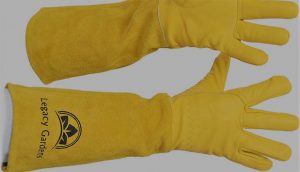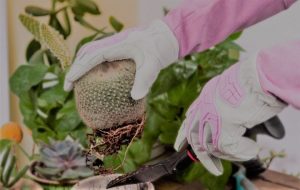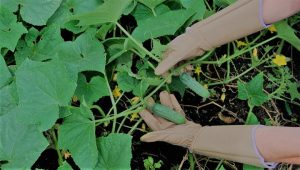Poison ivy can make a backyard adventure unpleasant for many people. If you’re an Amazon jungle explorer and exploring a new and potentially dangerous area for the first time, you may face some poisons. If you are carrying poison ivy on your skin, what should you do? How do you avoid the contamination of poison ivy? In this case, gloves can be the best for the task.
So, today I would like to introduce you to some of the best gloves for removing poison ivy on the market. I’ll go over how to choose the right pair, what features to look for and store your gloves next time. So, Let’s move!
What is Poison Ivy?
Poison Ivy is a common skin rash caused by contact with the American Ivy Plant. It’s also sometimes referred to as Poison Oak or Poison Sumac. It is a type of dermatitis caused by contact with certain types of plants.
The rash typically takes the form of blistery, pink, or red raised patches on your skin. Sometimes, the rash will form small blisters on other body parts, such as your lips or eyelids. It appears for a few days and then slowly fades, but it can last for weeks or even months. If the rash does not fade after a few weeks, you may have to contact a consultant.
Can you pull poison ivy with gloves?
Poison ivy is infamous for causing painful, itchy rashes and blisters on the skin. The plant’s active components, urushiol, are a type of oil that remains potent on poison ivy-proof clothes and can cause contact dermatitis. There are several factors involved that affect whether one can safely pull poison ivy with gloves. One such factor is the quality of the gloves.
When touching it, poison ivy and its toxins can quickly spread through the skin. A good pair of gloves will completely protect your hands from direct contact with poison ivy. But if you’re wearing a cheap pair, they won’t have the same effect on keeping particles at a safe and comfortable distance.
When to Remove Poison Ivy?
Poison ivy thrives in warm and moist environments. When the plant has grown too large, it is time to remove it. Removing poison ivy can be tricky if you do not know what to look for, but it is possible. For example, if the vine has grown up around nearby trees or fences, you may have to cut away the parts that cling to them before removing them.
The best way to remove poison ivy is to wear protective clothing and a face mask. When wearing this gear, cut the plant you identified as poison ivy into small pieces using a weed trimmer and remove them from the property. Dispose of any plant parts in plastic bags so they do not end up in your compost pile or garden.
If you apply the oil of poison ivy to the skin, the oils will remain on your skin. The oils will take about six hours to absorb your body completely. It is very important to wash all affected areas thoroughly with soap and water as soon as possible after exposure.
How to Remove Poison Oak Plants?
Poison oak is an invasive shrub found in various locations, including near trails, fields, and swampy regions. This plant can cause a rash to form on the skin that has come in contact with its toxic sap. Here are steps you can take to control poison oak plants without chemicals.
Step 1: Choose a location with poison oak plants near your home. It will cut the chances of stepping in any poison oak plant sap, leading to an infection or mild irritation.
Step 2: Dig a hole 6 inches deep and about 2 feet away from the base of the poison oak shrubs for each plant you want to remove. Also, you can use this time to add some dirt back into the hole to help with drainage and improve soil quality.
Step 3: Apply a layer of mulch around the base of each poison oak plant. Its layer prevents sunlight from reaching the roots and encourages water retention. Mulch will also make it more difficult for the plant to spread its seeds.
Step 4: Use a gloved hand to apply a handful of soap to the tops and bottoms of each poison oak plant. The soap will help prevent sap from spreading.
Step 5: Please wait 24 hours for the poison oak plants to dry before removing them from the ground one at a time. The dead plant can be removed either by digging them out or cutting them down with a pair of shears for pruning shears. Store poison oak plants in your compost pile until you are ready to have them removed by the city or county for proper disposal.
Step 6: Remove all poison oak plants from the ground and remove all plants that may have fallen over to the ground. If there are other plants nearby, check them for sap, as you may be able to remove them simultaneously.
6 Best Gloves For Removing Poison IVY
1. Thxtoms Latex Gardening Gloves Heavy Duty
ThxToms gardening gloves are 100% high-quality latex and can resist strong acids, alkali, and oil. With each pair of these gloves, you can clean right up to your elbows without worrying about getting rashes or burns.

The Heavy-duty gloves can provide you with long-lasting protection against harsh elements for up to 10 continuous hours. It has been proven that latex gloves can protect you from chemicals quite easily when it comes to working in the garden. The Chemical-resistant design allows you to lock the gloves tight to ensure that they do not move around when cleaning.
Pros
- The ivy gloves have a comfortable and convenient design. It is extremely easy to use. You can clean all day without worrying about getting burns or rashes.
Cons
- These gloves do not offer extremely high levels of Protection.
2. Best Garden Gloves for Poison Ivy
If you are gardening surrounded by thorny bushes or cacti, you may need protective Gardening Gloves to keep your hands safe. Legacy garden gloves can protect against thorns and cuts that you might suffer even if you avoid them as much as possible.

The Legacy gardening gloves are made with high-grade materials to provide strength and flexibility. It can keep you safe even if you must work inside the garden under the hot sun, rain, or even on icy mornings. Protect your hands from cuts while pruning rose plants, cleaning cacti, or washing them with the garden hose.
Pros
- These gloves are made with stretchy material to keep them comfortable for you. You can easily wear them when working in a garden on a sunny day.
Cons
- Many customers are concerned about the sizing of this product. The sizes run small, so make sure that you order one size bigger than what you normally wear.
3. Atlas 772 Nitrile Coated 26-inch Gloves
Do you need Nitrile Coated best gloves for poison ivy that stand up to heavy-duty work? Atlas 772 gloves are made from a special nitrile compound softer than the standard latex and last 2-3 times longer. It is also textured for easier handling and even has a long cotton lining for increased comfort.

The Nitrile Coated gloves are ideal for handling chemicals, cleaning, or heavy-duty work. It protects hands against irritants and lubricates while you clean. The gloves come with water-resistant protection when working in a wet environment. The 3-inch outermost barrier resists punctures and helps prevent odors and stains from piling up.
Pros
- Atlas 772 gloves are perfect for anyone looking for a better pair of plain cotton gloves. It is comfortable and provides adequate protection when working with rough or sharp materials.
Cons
- The gloves are prone to ripping if used too frequently. The gloves may not be more durable.
4. Vgo Premium Genuine Anti-Impact Gardening Gloves
When you spend hours in the garden or landscaping, you know to put on a pair of sturdy gloves to protect your hands. If you work with thorny plants or branches, old-fashioned protection may not be enough. It would help if you had something more like these Gardening Gloves from Vgo. You can use these gardening gloves for anything in the garden.

This pair of long gloves are made from premium genuine goatskin leather, providing maximum comfort and durability. The best gardening gloves for poison ivy are very gentle on the skin, so you don’t have to worry about roughness or allergic reactions. With the addition of rubber dots on the palms and fingers, you get even more protection than usual.
Pros
- The materials used in gloves are high quality, so they have a strong resistance to abrasion and impact. You can also use them for other outdoor activities such as planting and tending flowers.
Cons
- This pair of gloves fit a little tight, but they do stretch, so you need to give it some time to adjust.
5. Magid Rose Pruning Medium Thorn Resistant Gardening iny Gloves
If you are looking for high-quality gardening gloves to protect against garden thorns, scratches, and cuts. Magid Rose gardening gloves are going to provide you with safety and comfort. These poison ivy gloves are designed to offer durability, flexibility, and protection against garden thorns when gardening in the rose bed.

The premium quality materials used in making these gloves will allow you to have a better grip on your gardening tools and equipment. You can easily clean your gloves with a garden hose or bucket and soap. The cut-resistant feature of the gloves protects your hands when you trim rose bushes with hand tools such as pruners and loppers. The gloves have adjustable Velcro closures that ensure they fit perfectly on your hands.
Pros
- The razor-resistant fingertips on the gloves will allow you to safely prune your plants. Your hands won’t become itchy because of the latex-free material used for these gardening gloves.
Cons
- They might also lose some of their flexibility because they do not feature any special features as far as padding or grip is concerned.
6. Vgo Premium Goat Leather Thornproof Gardening Gloves
Are you looking for the best long gardening gloves that protect your fingers from thorny plants? Look no further, Vgo Premium Goat Leather Gloves can help keep your fingers safe from dangerous thorns as you work in your garden. It provides Protection and flexibility without compromising on comfort.

The gloves are made from durable goatskin and feature a thick, waterproof leather palm and secure-fitting wrist closure. It is capable of protecting your hand from even large thorns if you encounter them while working outside in your garden. The textured surface also makes it easy to clean, eliminating the need for frequent washing.
Pros
- The soft material allows it to absorb blows and keep your hand intact even if a thorn happens to pierce through it. These gardening gloves can protect you from blisters, broken nails, and cuts when doing gardening tasks.
Cons
- The stitching is unprotected, and it’s too thick to allow a grip. If the weather is too hot, they can make your hands sweat more than usual.
Which Gloves Will Help You Remove Poison Ivy Fast?
| Product Name | ThxToms 14″ Heavy Duty Latex Gloves | Legacy Gardens Thorn and Cut Proof Protective Gloves | Atlas 772 Nitrile Coated 26-inch Gloves |
| Material | latex | Leather | Nitrile coating |
| Resistant | Chemical Resistant | Cut Resistant | Chemical Resistant |
| Color | Black | Yellow | Yellow |
| Anti-Slip | Yes | No | No |
| size | 14″ | X-Large | 2 Count (Pack of 1) |
Buying Guide to Safe and Effective Poison Ivy Removal Gloves
Poison ivy is a pesky weed that can easily take over a garden or lawn. If left unchecked, it can quickly become a hazard to people and pets. Several different gloves can be used for this task, and it is important to choose the right one for your needs. Protection is one of the factors you will want to consider when purchasing a pair of gloves. Here are some tips to make buying these gloves a safe and successful experience.
Material
Many gloves are made from a material called vinyl. The vinyl gloves are the least expensive of all the options you can choose from, but they do not provide much protection. Vinyl is a material that used to create these gloves can make your hands itch by touching them with your bare skin. The best glove to use when removing poison ivy is a latex glove. This type of glove will provide you with some protection and even have antibacterial properties.
Protection
Protection is number one on the list of things you want to consider when purchasing a pair of gloves. The primary purpose of most gloves is to protect your hands, so they should not be uncomfortable and irritating. You do not want to have anything that will cause you discomfort unless necessary. The gloves that are made from vinyl materials are going to provide little or no protection. Vinyl materials will tend to absorb oil and sweat, causing your skin.
Comfort
Comfort is another consideration when selecting the right gloves for removing poison ivy. You may want a flexible one, but you do not want anything that will cause you to scratch your face or rub your nose relentlessly. The leather options will provide the most comfort out of all the options that you have available. They also help protect you from rubbing against rocks and other objects in nature, which can cause an allergic reaction.
Dexterity
The dexterity of the gloves that you choose for removing poison ivy will help you in so many ways. Having a pair of gloves that are made from leather will give you a much better grip than vinyl or latex materials. If you need to get your hand dirty, then a pair of leather gloves will be the best choice for removing poison ivy. The leather material does not absorb oils or sweat, which can cause irritation and lead to an allergic reaction.
FAQ
Where does poison ivy grow?
Poison ivy can be found in all the United States except Alaska and Hawaii. Poison ivy grows in wooded areas, fields, and various parts of the country.
Should you wear gloves when removing poison ivy?
Yes. When removing poison ivy, you should always wear gloves. The oils from the poison ivy can irritate the skin, so wear gloves to protect your hands and avoid getting them too close to your eyes.
How do you clean dirty garden gloves?
Many of our customers find out how poison ivy oils will transfer to your hands if you do not wash them immediately. The best way to remove the oils is to wash your hands with soap and water.
How long does poison ivy stay on gloves?
Most gloves taken off immediately after being exposed to poison ivy will still be relatively clean. A glove will clean by itself if you leave it on your hand for 15-20 minutes, then wash it with soap and water.
Final Thoughts
A thick, natural fiber is also an excellent ingredient for gloves to protect you from poison ivy. The best gloves for removing poison ivy would be disposable since they are easy to use and can be disposed of when needed. They can also help limit the chance of contamination, keeping you safe from this troublesome weed. If you’re looking for the perfect gloves to remove poison ivy this summer, these should work fine.

I am not a good blogger but I started blogging when I was in my college. one day scrolling my social media pages and top of the page one notification was coming like this “ earn money from blogging”.then I clicked that notification. After that, I was confused that which niche is better for me. Finally, I selected the niche and I was comfortable with that glove’s reviewer.

